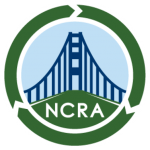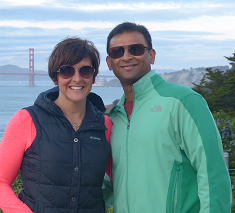By Nikhil Balachandran, Zabble Inc. and NCRA Board Member
When I signed up for the Chou Hall tour on a short notice, I wondered how many people would actually show up. I was surprised to see at least 15 people at the entrance of the UC Berkeley Haas School of Business. The crowd was good mix of waste industry folks, consultants, non-profits, sustainability managers from private companies and curious individuals. Kudos to NCRA’s Memberships, Events and Activities Committee (MEAC) who quickly coordinated the tour with the UC team and Juliana Gerber for sending out the sign up emails to orchestrate a successful event within a couple weeks.
It wasn’t hard to spot the right group when every attendee had either a reusable coffee mug or water bottle. We were greeted by the Green Team – Danner-Doud Martin, Assistant Director of the Berkeley-Haas International Business Development Program, Jessica Heiges, a Master’s student in the College of Natural Resources and NCRA Member Lin King, Cal Zero Waste Manager and veteran at championing university recycling programs.
After a quick round of introductions, we were made aware of Haas’ guiding principles etched on the walls in front of us.
- Question the Status Quo
- Confidence Without Attitude
- Student Always
- Beyond Yourself
So it’s no surprise that Chou Hall is aiming to be the first academic building to achieve the trifecta in Green Building certifications: LEED Platinum, WELL and TRUE Zero Waste.
A fully donor funded building, the 6 story building has received $60m in funding for the construction of the 80,000 sq ft building. It consists of 8 tiered classrooms with a total of 858 classroom seats, a 300 person event space, numerous study rooms and a cafeteria.
From the moment you enter the building, you can feel the openness in design and a freshness in architectural style. Having opened only a year back, Chou Hall has been making steady progress towards diverting more than 90% of discards from landfill every month. This is a mandatory requirement by TRUE, among others that ensure contamination is kept under 10% and mandates the upper management to adopt a Zero Waste policy.
There is around 24,000 sq ft of exterior windows that provides ambient lighting, reducing the need for interior lighting, thus reducing electricity consumption by 38% compared to similar sized buildings. Not yet functional is a solar installation on the 6th floor balcony, with sweeping views of the Bay Area, that also provides shade. A greywater recycling system that harvests rainwater was installed to reduce water consumption by 40%.
Pack-in, Pack-out. Don’t Pout! – Everything in the cafeteria is served in reusable-ware, compostable, or recyclable containers. To top it all, Chou Hall does not have any landfill bins. You heard it right! According to Danner, their pack-in, pack-out policy for trash helps students and staff be aware of the waste they generate. The students are encouraged to find the landfill bins outside the building. To facilitate that, the Green team switched to a vendor that made compostable products that are 100% plant based and BPI and ASTM D6400 certified. All the paper has 100% post-consumer recycled content. There are also no chips or candy bags available in the cafeteria and that was an uphill battle that all departments eventually came to common ground on. Jessica Heiges made an interesting analogy to the no-indoor-landfill-bins policy likening it to the smoking ban on campus. That it takes a while for people to get used to and then becomes part of their routine. She also said that very little food waste is generated. Any leftovers are usually placed out on campus and is gone within minutes.
But what about all that contamination? – Oh yes! Of course. That’s where the frequent Zero Waste audits come in that are needed for the monthly reporting. The Zero Waste audits emphasize keeping track of specifics like the source of generation, category and amount. For example, the recycle bin in floor 3 had a lot of food scraps in clamshells. The Green Team meets as often as weekly to discuss their progress and make tweaks to their program. They also meet monthly with other departments and stakeholders like custodial or cafeteria staff to discuss solutions to roadblocks. Lin says contamination is also countered by consistent signage and color coding the bins and lids throughout the building. Using pop-off lids makes it easier for custodial staff to empty the bins on a regular basis to avoid overflow. Danner added that surveys were immensely helpful as an educational tool not just to measure feedback from people but to communicate how well they are doing and why they are doing it. With the mindset is to encourage research and innovation, rather than telling the staff and students what to do, Lin says the Green Team constantly comes up with innovative ideas to battle contamination issues.
With that our tour concluded and we went back to the cafe downstairs for lunch. We sat in the patio under the mighty redwoods impressed by the determination of the Green Team who were all there on a voluntary basis. We shared the latest information on the current economic condition and how they would shape the Zero Waste future.
Who’s next – With UC’s goal to achieve Zero Waste by 2020 and to reduce MSW per capita by 25% by 2025 and 50% by 2030, UC Berkeley’s Haas School has taken a strong step forward. They hope to apply their learnings from Chou Hall to other buildings on campus, share them with other campuses in the UC system and universities in the country. So, it isn’t unusual for UC Berkeley to embark on this journey, when they’ve made it a habit to ask, “Isn’t there a better way to do this?
# # #



